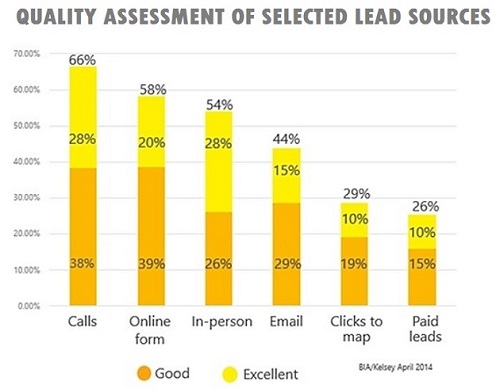As a B2B marketer, you're responsible for driving leads that ultimately convert to revenue.
But what happens when you overlook a valuable source of leads... such as inbound phone calls?
Nearly two-thirds (66%) of businesses rate phone calls "good" or "excellent" as a source of leads—more than any other inbound lead source, according to BIA/Kelsey. Remarkably, though, most B2B companies don't have a strategy to drive inbound calls. In fact, 60% of marketers don't know which campaigns drive inbound calls.

If you're not tracking and optimizing for inbound calls, you could be making decisions—including where to invest marketing dollars—that actually result in fewer leads.
Most people on the path to purchase bounce from offline to online and across channels. Inbound calls therefore provide an opportunity to gather insights from callers to get a 360-degree view of the buyer's path to purchase.
Moreover, inbound calls have the potential to reveal areas where you can better tailor messaging and the buyer experience to customer needs, addressing their top questions and objections. Finally, call intelligence can shed light on demographic details, including geographic location.
So here are 12 steps to help you get more inbound calls—and generate leads as well as customer intelligence.
1. Place your phone number prominently on your website, lead forms, emails, and landing pages
Giving prospects the option to contact you how and when they want builds trust, encourages engagement, and reduces abandonment. If someone makes the effort to call, you can bet they're more likely to be someone with whom you'd like to speak.
2. Use phone numbers strategically in advertisements
Adding a phone number to paid search ads has been proven to increase click-through rates by an average of 8%, according to Google. Using click-to-call buttons in social media ads can also boost lead generation.
Some companies are even using them to facilitate creative types of engagement, encouraging prospects and customers to call and leave messages, give feedback, or enter contests.
3. A/B-test with phone numbers and call-based calls to action
Test the placement, size, color, and overall treatment of the phone numbers on your landing pages and website. Also test the look and style of your click-to-call buttons for mobile pages.
Make your calls to action as clear as possible so your prospects understand why they should call and who will answer.
4. Include a phone number on your content assets
Although top-of-funnel content like blog posts and infographics may not prompt immediate action, don't forget to include a phone number on your mid-funnel content, such as e-books, white-papers, and case studies.
Adding a phone number will get prospects on the line at the moment of highest interest—when your company or solution is top of mind.
5. Use click-to-call buttons for your mobile audiences
Online engagement through lead forms and live chat works well for prospects on desktop computers, but not mobile users with small touchscreens. Click-to-call gives them the option to talk to a live person and quickly get their questions answered.
6. Always use call-tracking phone numbers
With the visibility afforded by call-tracking phone numbers, you can capture the keyword, ad, and landing page that a prospect viewed before making a phone call.
7. Empower your agencies and marketing distribution partners with call tracking
Whether you give your agency and distribution partners unique numbers or provide them logins to your call intelligence platform, make sure they have the tools to drive and track calls for you. Doing so will ensure proper attribution and increase your inbound call volume.
8. Integrate call tracking with your marketing automation to capture the entire multi-channel path to purchase
Integrate marketing automation data with call tracking so that when a prospect picks up the phone, you can tie that call to all previous online activity. And if a prospects calls early on but isn't ready to move forward with sales, having that data synced with marketing automation and retargeting is incredibly valuable for following up with the appropriate message.
9. Integrate call tracking with your CRM to tie calls to revenue
When call data is synced with your CRM, all of your leads have the correct marketing source, allowing you to tie actual revenue to your campaigns, programs, and media spending.
10. Capture valuable insights and signals in each phone conversation
With conversation intelligence, you can capture what's happening on your inbound phone calls to understand lead quality, test new sales messaging, monitor the competitive landscape, and optimize based on questions, objections, and actions. You can also conduct quality monitoring and track all types of conversions—such as whether a demo was requested or a follow-up call scheduled.
11. Tailor prospect communication based on conversation intelligence
With call intelligence tied to your CRM and marketing automation solutions, you can customize communication and messaging so it's highly relevant and meaningful.
If prospects have already spoken with a sales rep, use conversation intelligence to follow up accordingly. Send them content to address their use case and pain points. If they mentioned a competitor on the call, send them a buyer's guide that demonstrates exactly why your solution is better. If the prospect is early in the buying cycle, send emails that will help them move down the funnel.
12. Optimize marketing spend and campaigns
See the big picture of your marketing performance and your customers' path to purchase to drive more of the prospects that ultimately turn to sales.
(Learn more on how to tap into the power of the phone with the e-book Calls Are the New Clicks: How B2B Marketers Can Tap Into the Power of the Phone.)




